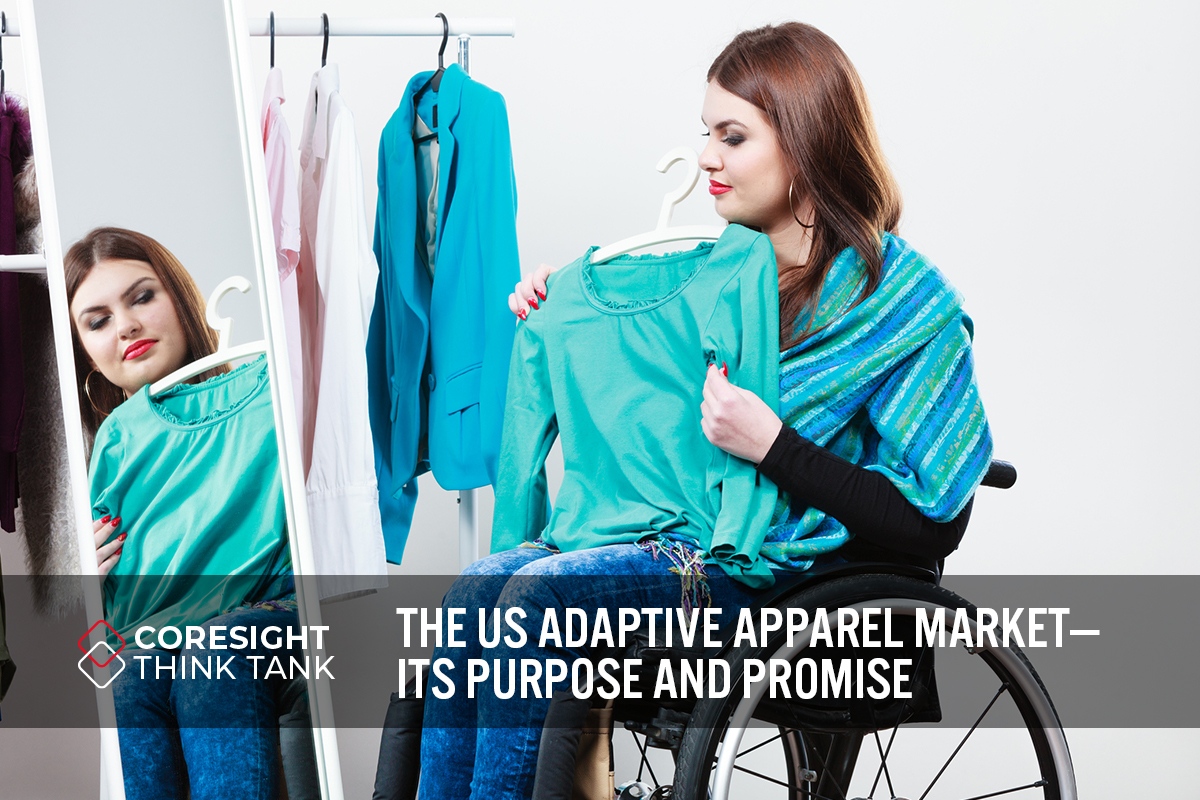
DIpil Das
What’s the Story?
Adaptive apparel refers to clothing and footwear that serves needs not met by typical fashion. It is specifically designed to help disabled people to dress and live with greater ease and independence. Sometimes referred to as “stress-free” clothing, adaptive apparel constitutes a relatively new industry, with major retailers and brands pioneering the space over the past five years. The market for adaptive apparel includes people with disabilities, people with mobility, sensory or motor processing difficulties and people undergoing certain types of medical treatment. Market growth is being spurred by an increasing commitment to the principle of inclusivity—providing equal access in various realms of society to people who had previously been excluded or marginalized. Inclusivity as a movement has accelerated in light of the recent resurgence of social justice movements in the US, helping to inspire a global conversation on diversity and representation. In the case of disabled people, this inclusivity affects every aspect of life—employment, social engagement and personal choices in clothing and footwear. (Please note that for the duration of this report, the term “adaptive apparel” will refer to both clothing and footwear.)Why It Matters
The positive impact of accessible design on disabled people cannot be emphasized strongly enough. We believe adaptive apparel is one of the biggest opportunities in retail, and one of the most significant.- Disabled people represent 12.7% of the US population, according to the US Census Bureau, but remain underserved in terms of market choices that are fashionable and/or functional.
- Coresight Research estimates that the market potential for adaptive apparel far exceeds the present level of adaptive spending; disabled people are requesting new products as well as new product categories.
- Beyond the numbers, the social and psychological impact of adaptive apparel cannot be ignored. It has an extraordinary ability to restore dignity and enhance confidence in disabled people as they go through their daily lives. Coresight Research heard from individuals who said they are often noticed for their disability first. Apparel is important because it helps people represent their personal style and feel more like themselves. Some individuals emphasized that they wanted apparel choices that allowed them to fit in with their friends and colleagues. One individual told us that clothing choices are important to him in breaking the perception that “he dresses that way because he‘s in a wheelchair.”
The US Adaptive Apparel Market: A Think Tank
Market Potential The adaptive market is evolving. At present, the supply of adaptive apparel products based on the retailers and brands supporting this space is limited relative to projected demand. In focus groups and surveys conducted by the University of Missouri in 2014, 2016 and 2018, disabled people reported that an inability to find adaptive clothing led to them cancelling or avoiding various activities and events, including swimming, graduations, weddings, parties, sports competitions and church services. Furthermore, the studies indicated that in a number of cases, apparel itself was a barrier in the form of dress codes, professional and otherwise. Some participants reported modifying their own clothing through “hacks,” learning to sew or hiring seamstresses. Coresight Research estimates that the potential market for adaptive apparel is nearly 50 times greater than the current state of supply. In 2021, we estimate that adaptive apparel spending will total $1.3 billion, while the potential addressable market is worth $64.3 billion (see Figure 1). In the near future, we foresee a fully built-out market with consumer choice across all price points—from mass to luxury. Furthermore, we expect that consumer spending on adaptive apparel will grow at a faster rate than overall spending on apparel. This strong growth is anticipated due to the following factors: untapped demand—disabled people seeking entirely new product categories; new brands and retailers entering this space; advances and innovations in fit technology, materials and digital design; and increasing employment opportunities for disabled people, which will increase both spending power and demand for adaptive apparel products. This expansion will undoubtedly be accelerated as competition spurs innovation in such areas as ambulatory, sensory and dexterity, and cognitive design.Figure 1. Projected 2021 Adaptive Apparel Spending and Total Potential Addressable Adaptive Apparel Market, by Age Group [wpdatatable id=932 table_view=regular]
Source: US Bureau of Labor Statistics/US Census Bureau/Coresight Research A Closer Look at the Adaptive Consumer In 2019, 41.1 million Americans reported a disability to the US Census Bureau. People aged 35–64 represent the largest portion of this population, at 37% (15.3 million Americans). However, looking at each age group, the highest proportions of disabled people are in the 65–74 and 75+ groups (see Figure 2).
Figure 2. Americans with Disabilities in Each Age Group, 2019 (%) [caption id="attachment_127104" align="aligncenter" width="725"]
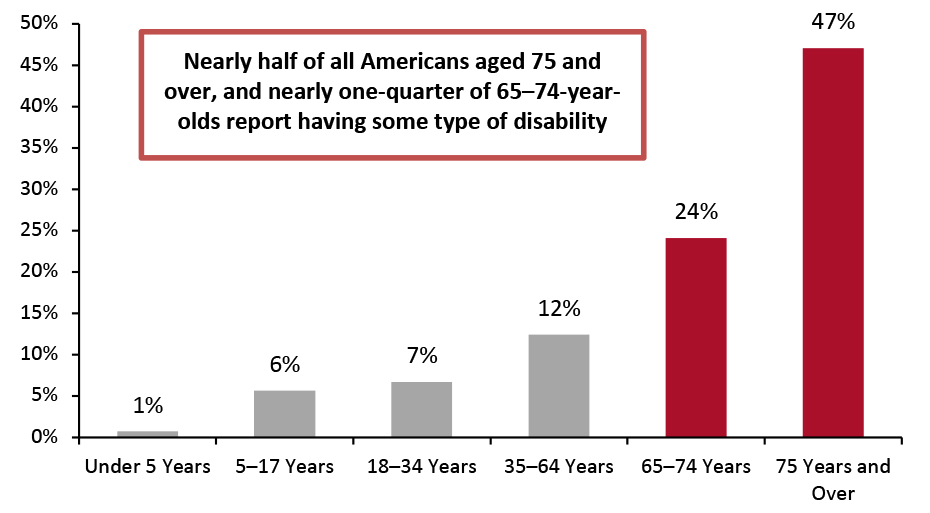 Source: US Census Bureau[/caption]
The 2019 census report also presents the disability numbers broken down by type of disability and category of difficulty: vision, hearing, cognitive, ambulatory, self-care and independent living. Of course, an individual can experience more than one disability—78.2 million disabilities were reported by the 41.1 million respondents, an average of 1.9 disabilities per person.
Source: US Census Bureau[/caption]
The 2019 census report also presents the disability numbers broken down by type of disability and category of difficulty: vision, hearing, cognitive, ambulatory, self-care and independent living. Of course, an individual can experience more than one disability—78.2 million disabilities were reported by the 41.1 million respondents, an average of 1.9 disabilities per person.
- Ambulatory difficulties were reported by the greatest number of disable people (20.8 million individuals—8.3 million aged 35–64 and 11.3 million over the age of 65).
- Cognitive difficulties were the second most prevalent (15.8 million individuals), closely followed by independent living disabilities (14.7 million individuals).
Figure 3. Adaptive Products by Disability Type and Age Group [wpdatatable id=933 table_view=regular]
Data from 2019; latest data available from US Census Bureau *US Census Bureau categorizes disabilities into six types; Coresight Research added “Healthcare” Source: US Census Bureau/Coresight Research Recent Developments: Consumer-Centricity, Technical Innovation and Community Are Pushing Adaptive Forward Below, we detail four recent notable developments in the adaptive apparel space since our last deep dive into the US market two years ago. 1. Ministry of Supply Launches the Kinetic Adaptive Pant In October 2020, Ministry of Supply launched the “Kinetic Adaptive Pant,” a product that aims to bring comfort, functionality and style to seated wear for men and women. According to the company’s President and Co-Founder Gihan Amarasiriwardena, the new product provided Ministry of Supply an opportunity “to double down on our human-centered design process.” Design of the pants began at the Stavros Center for Independent Living in Massachusetts, where the company held focus groups with individuals using wheelchairs and personal care assistants. It then took these findings and worked with WeAdapt from the University of Minho in Portugal to investigate ways of reducing pressure and irritation of seated users, primarily in the waist and the knee areas. After a process of rapid prototyping and testing seven features for durability and ergonomics, Ministry of Supply tested its kinetic adaptive prototype material (a high-stretch, warp-knit) with gold-medal Paralympians who provided feedback on fit, features and aesthetics. The final product features a pitched waistband, darting at the knee for extra fit, low-profile pockets, sleek tapered legs and reinforced grab holds for easy dressing. The Kinetic Adaptive Pant is built to order and customized based on a customer’s needs, with optional features including Velcro openings and catheter access. Ministry of Supply reported that since the product’s launch in October 2020, customer feedback has been positive, strong and engaged, and that this early response signals a path to an expanded offering. [caption id="attachment_127105" align="aligncenter" width="725"]
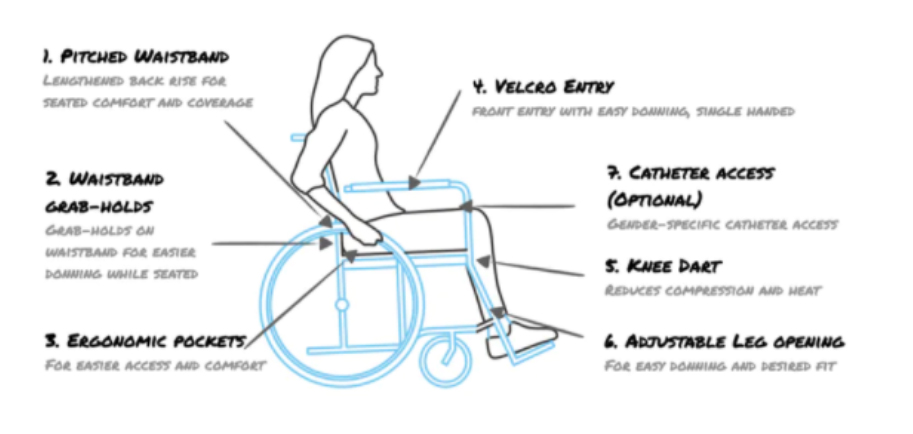 Source: Ministry of Supply[/caption]
Founded in 2010 by MIT engineers, Ministry of Supply applies scientific and technical expertise to push fashion forward in such areas as temperature regulation, sustainability and zero-waste, material innovation and fit technology. The company has won numerous awards, including NASA’s Innovation Award for its Apollo shirt, which uses NASA technology to regulate temperature, and Fast Company’s Innovation by Design award for its Mercury Intelligent Heated Jacket, which incorporates a smart thermostat.
2. Global Brands Group Launches JuniperUnltd, a Marketplace and Community Hub
In September 2020, Global Brands Group launched a content and e-commerce marketplace for disabled people, JuniperUnltd (Juniper Unlimited), in collaboration with Maura Horton, Chief Community Officer and Founder of MagnaReady, a patented solution for magnetic apparel. The site offers a mix of original and curated content on a wide variety of topics, including wellness, fashion, home, food, technology and caregiving. JuniperUnltd includes brands and products across the categories of apparel and accessories, health and wellness, and lifestyle. The marketplace has more than doubled its brand portfolio since inception: It launched with eight brands and, as of January 2021, now features 18 brands.
In addition to products, JuniperUnltd provides a content hub for consumers. The site offers a podcast series covering inclusive design, legislative efforts and accessibility, hosted by Editor-at-Large Sinéad Burke, a writer and activist advocating globally for accessibility. The community portal also features a broad array of content, including personal stories and profiles, industry articles on adaptive living and design, employment opportunities, discussions of disability challenges and helpful resources.
Randi Nolan, EVP of Social Impact Brands for the hub, described JuniperUnltd’s central mission to Coresight Research:
Source: Ministry of Supply[/caption]
Founded in 2010 by MIT engineers, Ministry of Supply applies scientific and technical expertise to push fashion forward in such areas as temperature regulation, sustainability and zero-waste, material innovation and fit technology. The company has won numerous awards, including NASA’s Innovation Award for its Apollo shirt, which uses NASA technology to regulate temperature, and Fast Company’s Innovation by Design award for its Mercury Intelligent Heated Jacket, which incorporates a smart thermostat.
2. Global Brands Group Launches JuniperUnltd, a Marketplace and Community Hub
In September 2020, Global Brands Group launched a content and e-commerce marketplace for disabled people, JuniperUnltd (Juniper Unlimited), in collaboration with Maura Horton, Chief Community Officer and Founder of MagnaReady, a patented solution for magnetic apparel. The site offers a mix of original and curated content on a wide variety of topics, including wellness, fashion, home, food, technology and caregiving. JuniperUnltd includes brands and products across the categories of apparel and accessories, health and wellness, and lifestyle. The marketplace has more than doubled its brand portfolio since inception: It launched with eight brands and, as of January 2021, now features 18 brands.
In addition to products, JuniperUnltd provides a content hub for consumers. The site offers a podcast series covering inclusive design, legislative efforts and accessibility, hosted by Editor-at-Large Sinéad Burke, a writer and activist advocating globally for accessibility. The community portal also features a broad array of content, including personal stories and profiles, industry articles on adaptive living and design, employment opportunities, discussions of disability challenges and helpful resources.
Randi Nolan, EVP of Social Impact Brands for the hub, described JuniperUnltd’s central mission to Coresight Research:
We developed JuniperUnltd to be a platform that connects, bridges and builds community through content and design. Our marketplace and content hub is intentionally rooted in the communities of disability, caregiving and aging, to create space to serve them, and learn from them so that we can lead and partner with individuals and businesses to design a more accessible, equitable and inclusive world for all.
3. FFORA Partners with Microsoft, Livestreams on Twitch x Live Nation In fall 2020, lifestyle and accessories brand FFORA launched a new bottle and holder, affording individuals a practical and stylish option for attaching their water bottles to their person or wheelchair. FFORA (derived from “fora,” the Latin plural for “forum”) launched in 2019 and focuses on accessible luxury products, primarily for wheelchair users. Lucy Jones, the company’s Founder and CEO, is widely recognized in the field of inclusive design and won the Parsons School of Design’s Womenswear Designer of the Year award in 2015 for her Seated Design collection. She was commissioned by the Museum of Modern Art (MoMA) to prototype a pair of “seated pantyhose” for its second fashion exhibition. [caption id="attachment_127106" align="aligncenter" width="630"]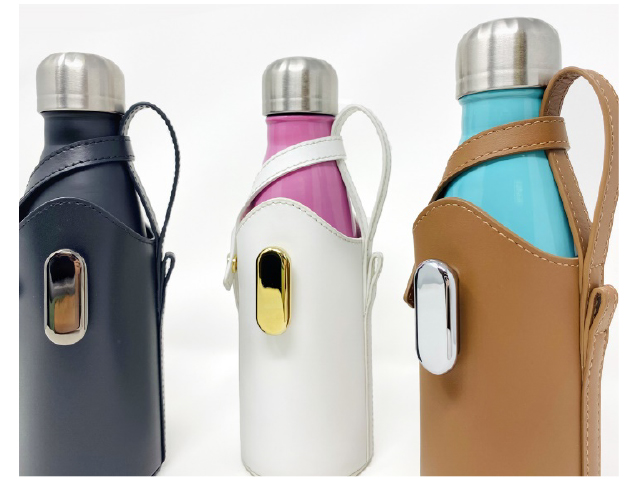 Source: FFORA[/caption]
In November 2020, FFORA collaborated with Microsoft on a commercial for its series, What Matters Most, which shows Lucy Jones using technology to develop FFORA products and collaborating during “work from home” as she continues to fulfill the company’s mission of placing disability at the forefront of design.
Due to the great response of the Microsoft commercial, FFORA once again teamed with Microsoft on a 30-minute Live Nation x Twitch livestream in December, going online prior to a Tayla Parx concert for thousands of viewers. Microsoft streamed FFORA’s commercial followed by Lucy Jones’ livestream about the FFORA brand, products, design process and the significance of the customer. Jones has described the experience as “surreal” and commented on the positive feedback FFORA has received since the event, including many personal stories from both individuals and communities of customers attesting to the many ways in which accessible products are impacting to their lives.
According to FFORA, it continually receives requests from customers for products they are seeking, including cellphone holders, seat cushions, bags for the back of a wheelchair, outerwear, and bras and intimates. Jones told Coresight Research that outerwear is one of the biggest needs—coats and jackets that complement the torso (not too bulky) of a person seated in a wheelchair and provide protection, with special attention to keeping legs warm and dry and sleeves clean, to avoid collecting dirt from the wheels when pushing.
Jones emphasized that wheelchair accessories can be integral to self-expression. For example, customers are requesting stylish coverings for parts of the wheelchair, including the seat; this presents an opportunity for home goods retailers to enter this space and offer, for example, a variety of colors and prints. Jones said, “It is about choices. Customers want to have market choices for the items that best suit them—regardless of where they shop. Customers want to feel confident and proud, and so access to more choices is crucial.” She added that the disabled community today still does not have a wide variety of options, especially ones that showcase personality and identity, so the opportunity is wide open to collaborate with disabled people to innovate in the market.
The company reported that sales doubled in the 2020 holiday season compared to the 2019 holiday season. As Jones pointed out, this was “remarkable during Covid-19” and highlights the fact that many customers gifted FFORA’s products.
4. Zappos Adaptive Launches “Single and Different Size Shoes Program”
In July 2020, adaptive apparel retailer Zappos Adaptive launched its “Single and Different Size Shoes Program,” which allows consumers to purchase a single shoe or a pair consisting of two different sizes. To gauge consumer interest in the program, the company posted a survey on Facebook to which it received over 2,600 responses within three weeks. According to Dana Zumbo, Zappos Adaptive’s Business Development Manager, the survey had to be terminated due to the overwhelming response. Individuals shared personal stories detailing how the option of buying a single shoe and/or different-size shoes would benefit them. Zappos planned to launch the program in March 2020 but was delayed due to the pandemic, with new plans to launch in 2021. However, based on the feedback and compelling consumer need, the launch was moved up to July 2020.
Interestingly, the solution is also reaching beyond individuals with disabilities; for example, skateboarders are purchasing from the program. Due to consumer demand for more styles and brands as part of the program, Zappos has now partnered with six new brands—Brooks, Dansko, Friendly Shoes, Merrill, Uggs and Vans—and is expanding its partnership outreach to more brands, including Birkenstock, Crocs, Florsheim, Keen and RSVP. Zappos is also working with its existing brand partners to further the discussion around inclusive designs to provide additional options for disabled people.
Zappos Adaptive was launched as curated shopping experience in 2017, to provide consumers with adaptive solutions and options. Initially launched with two brands on the company’s website, the platform has evolved to include an assortment of adaptive clothing and footwear for adults and children. Today, Zappos Adaptive offers products across the following categories: Easy On/Off Shoes, AFO Friendly (ankle foot orthosis), Orthotic Friendly, Easy Dressing, Seated Clothing and Sensory Friendly. Additionally, the company offers Adaptive Intimates and Underwear, Medical Wear and Small Sizes.
Competitive Landscape
In Figure 4, we summarize the major players in the US adaptive apparel market.
Source: FFORA[/caption]
In November 2020, FFORA collaborated with Microsoft on a commercial for its series, What Matters Most, which shows Lucy Jones using technology to develop FFORA products and collaborating during “work from home” as she continues to fulfill the company’s mission of placing disability at the forefront of design.
Due to the great response of the Microsoft commercial, FFORA once again teamed with Microsoft on a 30-minute Live Nation x Twitch livestream in December, going online prior to a Tayla Parx concert for thousands of viewers. Microsoft streamed FFORA’s commercial followed by Lucy Jones’ livestream about the FFORA brand, products, design process and the significance of the customer. Jones has described the experience as “surreal” and commented on the positive feedback FFORA has received since the event, including many personal stories from both individuals and communities of customers attesting to the many ways in which accessible products are impacting to their lives.
According to FFORA, it continually receives requests from customers for products they are seeking, including cellphone holders, seat cushions, bags for the back of a wheelchair, outerwear, and bras and intimates. Jones told Coresight Research that outerwear is one of the biggest needs—coats and jackets that complement the torso (not too bulky) of a person seated in a wheelchair and provide protection, with special attention to keeping legs warm and dry and sleeves clean, to avoid collecting dirt from the wheels when pushing.
Jones emphasized that wheelchair accessories can be integral to self-expression. For example, customers are requesting stylish coverings for parts of the wheelchair, including the seat; this presents an opportunity for home goods retailers to enter this space and offer, for example, a variety of colors and prints. Jones said, “It is about choices. Customers want to have market choices for the items that best suit them—regardless of where they shop. Customers want to feel confident and proud, and so access to more choices is crucial.” She added that the disabled community today still does not have a wide variety of options, especially ones that showcase personality and identity, so the opportunity is wide open to collaborate with disabled people to innovate in the market.
The company reported that sales doubled in the 2020 holiday season compared to the 2019 holiday season. As Jones pointed out, this was “remarkable during Covid-19” and highlights the fact that many customers gifted FFORA’s products.
4. Zappos Adaptive Launches “Single and Different Size Shoes Program”
In July 2020, adaptive apparel retailer Zappos Adaptive launched its “Single and Different Size Shoes Program,” which allows consumers to purchase a single shoe or a pair consisting of two different sizes. To gauge consumer interest in the program, the company posted a survey on Facebook to which it received over 2,600 responses within three weeks. According to Dana Zumbo, Zappos Adaptive’s Business Development Manager, the survey had to be terminated due to the overwhelming response. Individuals shared personal stories detailing how the option of buying a single shoe and/or different-size shoes would benefit them. Zappos planned to launch the program in March 2020 but was delayed due to the pandemic, with new plans to launch in 2021. However, based on the feedback and compelling consumer need, the launch was moved up to July 2020.
Interestingly, the solution is also reaching beyond individuals with disabilities; for example, skateboarders are purchasing from the program. Due to consumer demand for more styles and brands as part of the program, Zappos has now partnered with six new brands—Brooks, Dansko, Friendly Shoes, Merrill, Uggs and Vans—and is expanding its partnership outreach to more brands, including Birkenstock, Crocs, Florsheim, Keen and RSVP. Zappos is also working with its existing brand partners to further the discussion around inclusive designs to provide additional options for disabled people.
Zappos Adaptive was launched as curated shopping experience in 2017, to provide consumers with adaptive solutions and options. Initially launched with two brands on the company’s website, the platform has evolved to include an assortment of adaptive clothing and footwear for adults and children. Today, Zappos Adaptive offers products across the following categories: Easy On/Off Shoes, AFO Friendly (ankle foot orthosis), Orthotic Friendly, Easy Dressing, Seated Clothing and Sensory Friendly. Additionally, the company offers Adaptive Intimates and Underwear, Medical Wear and Small Sizes.
Competitive Landscape
In Figure 4, we summarize the major players in the US adaptive apparel market.
Figure 4. The US Adaptive Apparel Landscape: Major Brands and Retailers (Ordered by Most Recently Launched) [wpdatatable id=934 table_view=regular]
Source: Company reports Two Primary Catalysts for Market Growth The apparel market cannot be viewed in a vacuum; the social unrest of 2020 in the US provided an impetus for companies to take a closer look at their teams and hiring processes. We expect an increased focus on diversity and inclusion as companies continue to address corporate policies and procedures. Concomitantly, more opportunity for disabled people will necessitate more apparel choices spanning a broad range of categories including professional attire, casual wear, sportswear and footwear. In this environment, organizations and companies are launching employment initiatives in the adaptive community and are helping brands and retailers to understand the retail opportunity through panels and other educational events. Employment Increasing employment opportunities for disabled people is a boon to the expansion of the adaptive marketplace through increased demand and spending power.
- Empowered Cities Works Toward Equity and Opportunity for Disabled People
Figure 5. Populations of Disabled People: Boston, Los Angeles, New York City and Chicago [wpdatatable id=935 table_view=regular]
Data from July 2020 Source: Empowered Cities
- NYC Mayor’s Office for People with Disabilities: Employment Is Key to Financial Empowerment
If you are looking to provide employment opportunities for disabled people, you should first look inward to ensure that you are accessible. Your social practices as well as your physical and digital spaces must be accessible for people with all types of disabilities. In your journey to answer these questions and address some of the issues that you find, reach out to disabled people—and there are many community organizations and excellent national resources to assist you.
As part of its ATWORK program, the NYC team prepares individuals with disabilities for interviews. Speaking specifically about the importance of adaptive apparel in disabled people gaining employment, Jackson told Coresight Research:Looking professional is important to everyone. When clothing is ill-fitting, poorly conceived or poorly tailored, no one feels at their best. By wearing clothing that is uncomplicated, functional and durable, there is an added professionalism in not only appearance but in the confidence of that person.
Tara Accetta, Outreach Coordinator for the program, said that disabled people want to look like their coworkers and staff members. Eli Ramos, a fellow Outreach Coordinator, added that in his personal life, he dresses one step above to dispel any preconceived stereotypes concerning individuals with disabilities. The NYC team identified the following areas of opportunity for adaptive apparel and emphasized that the consumer needs to be involved in the design process:- Fashionable clothing for amputees and individuals with conditions that affect dexterity (including multiple sclerosis, Parkinson’s disease, cerebral palsy)
- Jeans that are fashionable
- Footwear for wheelchair users (including with heels)
- Jackets that are warm but not bulky
- Coats and raincoats/hoods and capes
- Formalwear
- Dresses
- Accessories made accessible with zippers—e.g., gloves, purses, handbags
- The Inclusively Platform Increases Job Postings by 100% and Job Applications by 10X Since Its Launch
- CFDA Partners with Runway of Dreams and Gamut Management on Fashion Employment Webinars
- Deborah Weinswig, CEO and Founder of Coresight Research, and Erin Schmidt, Senior Analyst at Coresight Research, joined other leading researchers in the field of adaptive apparel in the “Learning from the Researchers” webinar to discuss the current retail opportunity in the market. Read our insights from the event in our separate report.
- BNP Paribas and Court 16 Launch “Sound of Tennis”
Making tennis accessible to all players is fundamental to Court 16’s vision. This started with the original design of the club, curated on one level to make all areas of the academy accessible to people of all ages and abilities. It is a privilege to introduce the game to new players through Sound of Tennis, training athletes with vision impairments how to make proper contact with the ball—our ultimate on-court mission.
Hildegard Morales, one of the participants, gave the following personal testimonial:Sound of Tennis is a great program for the visually impaired and the blind community. It is not only learning how to swing a racquet but also listening to the ball, which has a bell in it and that takes concentration, but it is a lot of fun. There is good interaction with the coaches and the team. For me, it is a physical, mental, and social therapy. Socializing with people that experience the same vision loss made me realize that I was not the only one. My thoughts were, “I will try Sound of Tennis once,” but one year later, I am still here. It is fantastic.
[caption id="attachment_127107" align="aligncenter" width="680"]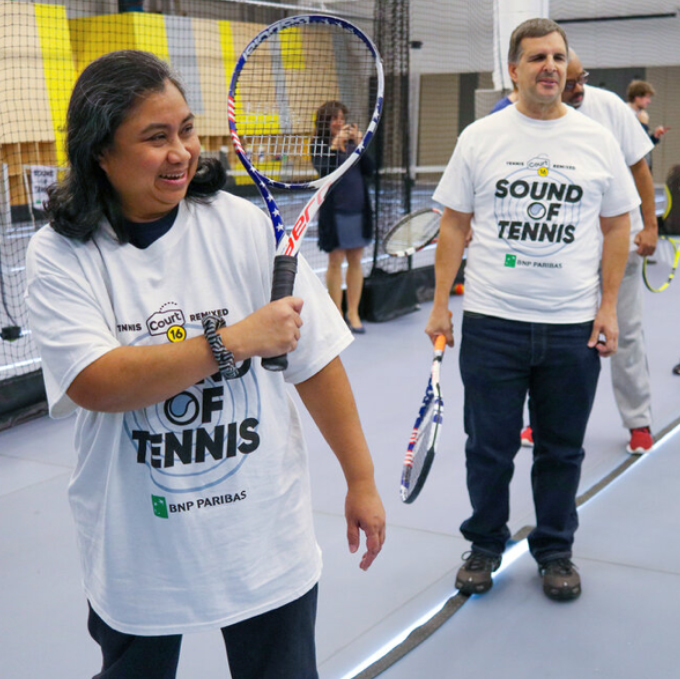 Participants in Sound of Tennis
Participants in Sound of Tennis Source: Court 16 [/caption]
What We Think
Adaptive apparel has grown and evolved as an industry over the past five years due in large part to new brands and retailers entering the space, which had previously been focused on apparel for older individuals. Tremendous progress has been made in getting it off the ground, with nearly 20 brands and retailers pioneering the space through adaptive brands, brand extensions and, most recently, marketplaces. We believe that adaptive fashion will maintain a solid sustained growth and present a sky-high opportunity to brands and retailers that are innovative and consumer-centric. The adaptive apparel market is built around user-centered design, and disabled people are signaling that they want more—more choices, more categories and more brands, from discount to luxury. For example, consumers are seeking nearly every apparel category in seated design. Outerwear was highlighted most frequently, with designs that keep consumers dry and warm without excess bulk, followed closely by professional wear and footwear for wheelchair users, a product category that is often overlooked. Employment initiatives will be one of the biggest factors driving adaptive apparel forward, as employment directly influences apparel purchases. Perhaps more important, however, is the indirect social impact on the organizations involved and ultimately on society as a whole. We summarize the tailwinds and headwinds of the US adaptive apparel market in Figure 6.Figure 6: US Adaptive Apparel Market: Tailwinds and Headwinds [wpdatatable id=936 table_view=regular]